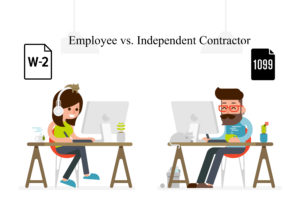Every summer, college, and graduate students participate in summer internships in various American companies. Internships allow students to gain invaluable hands-on work experience while providing companies with young and eager workers passionate about their industry. This is a mutually beneficial arrangement, and often, companies will hire their interns for permanent positions once they graduate from school, making internships an excellent pipeline for hiring new talent. Unfortunately, as the COVID-19 pandemic rages on, many companies’ offices are closed, with most of their workforce working from home. This leaves organizations in an unusual position to cut down on their internship, hire drastically, or cancel their internship programs altogether. If this “new normal” has shown us anything, though, it’s that businesses can run efficiently and effectively with virtual employees. Given the success of the work from home model for full-time employees, remote internships can be just as successful. … [Read More]
Why the future workforce will work from home
The work from home trend is not a new concept. Workers have been working from home from the dawn of civilization, but speaking strictly in the modern era, let’s take the past 40 years this trend has increased year after year. In 1979, with the OPEC oil embargo in its sixth year, the Washington Post published the article, “Working at Home Can Save Gasoline,” which suggests telecommuting could have eased the gas crisis. This article urged companies to introduce telecommuting to conserve gas. As you can imagine, employers were opposed to this idea initially. They used argument such as: How can you tell that the workers are doing any work at all from the comfort of their homes? Or, workers are missing out on crucial interactions with their team. But the counterarguments must have been strong enough to help support this trend as it keeps… [Read More]
Why outsource your contingent workforce management
The contingent workforce has been consolidated in the last few years and is here to stay for the foreseeable future. Companies utilize this sector of the workforce for all sorts of purposes from project base assignments to fulfill skill shortages & absences. The question arises, does your organization’s HR department has the bandwidth to identify, vet, and onboard contingent workers without disturbing their daily operations and without taking them away from your companies full-time employees. The answer to that question is, well it depends. Today’s contingent workforce is vastly different than it used to be. These workers are highly trained, specialized, and in-demand professionals. Moreover, they expect to be treated as such. Making sure the procurement process goes smoothly, guarantees employee satisfaction and retention. Identifying the right contingent worker: According to the Society for Human Resources Management (SHRM) it takes approximately 36 days to fill… [Read More]
The Benefits of Having an Internship Program
The concept of internship historically originates from an apprenticeship, the idea of training or preparing personnel for future employment. We typically associate internships with college students, but they can be older workers in pursuit of a new career. Internships are viewed as a vehicle to learn a new skill, gain and improve their knowledge and abilities with the end goal of gaining future employment in a particular field. These programs are mutually beneficial to both interns and employers. Interns can take advantage of in-person training and network opportunities the employer presents. Employers benefit by obtaining relatively inexpensive labor and by tapping into a pool of talent for future potential employment. Not to mention that by offering internship programs employers improve their brand recognition and status in the communities they operate. In a nutshell, internship programs are a win-win arrangement for both interns and employers…. [Read More]
Differences between an Employee vs. Independent Contractor
Every so often, I get the question from clients regarding proper classification of employee vs. independent contractor. Part of the reason why these questions are constantly being asked is that the exact definition of independent contractors vs. employees is not set in stone. Interpretation of laws and principals can provide a guide to employers in defining the business relationship between themselves and the candidate. As rule of thumb, I always use three sources when trying to answer these difficult questions. To define the status of an independent contractor, I refer to common laws and principals adopted by the federal government and the states, the Fair Labor Standards Act of 1938, and, finally, I take into account the decisions made by the courts. Especially in my home state of California, the third source of information gives me a road-map of what’s established as precedence from the… [Read More]
Hiring temporary workers for seasonal workloads
As the holidays are fast approaching, the demand for temporary or seasonal workers will rise. According to data from the U.S. Bureau of Labor Statistics, employment in the final months of the year has risen by up to 20% the past 6 years. There’s no doubt a growing U.S. economy has contributed to the magnitude of this expansion. The benefits of hiring temporary workers to boost your company’s productivity during seasonal demands cannot be understated. Some of the benefits of hiring temporary workers include: Provide flexibility in uncertain economy Smaller companies need to stay flexible when it comes to their workforce. Uncertain economic times are inevitable. Businesses are bound to experience periods of both increased and decreased customer demand. Being able to ramp up a workforce and, subsequently, scale it back when necessary is a very desirable tool for business owners. Introduces your company… [Read More]
The Three Buckets of Contingent Workforce
HR professionals in today’s ever-changing workforce climate are told to accomplish more with less. Tightening talent pool, changing technologies and trying to keep your employees happy are calling for more flexible and creative ways to solve your workforce challenges. Fortunately, becoming more strategic is in our DNA. For many, that increasingly means who we hire to help build the future of our companies. The contingent or contract worker has exploded in the last few years, growing from 10% of the workforce in 2010 to a predicted over 40% of the workforce by 2018, according to reports by the U.S. Government Accountability Office. This can certainly be credited to the rise of the gig economy in global markets. There are many categories of contingent workforce, below I drill down and try to categorize 3 common members of this labor pool. The Temp Worker This category… [Read More]
Get Real Savings Through Third-Party Payrolling
As organizations increasingly rely on contingent or contract workers to fill mission-critical roles, business leaders are looking for ways to boost their company’s bottom line savings. One scenario where this can be the case is the MSP/Vendor rate of third-party payroll utilization – the percentage of spend for contingent or contract workers who are sourced directly by the organization and W2 payrolled by a third party vendor. Increasing third-party payroll utilization offers many benefits to companies, from driving down costs to streamlining the talent acquisition processes and even reducing risk. Not all vendors, however, are structured for or support this approach. For example, when utilizing a staffing firm or staffing-aligned MSP to source for your open positions, be prepared to face markups that can range from 35% to 50% for agency-supplied workers. Rather than accept these markups unconditionally, business leaders should look for opportunities available… [Read More]
Hiring on a Trial Basis
Now more than ever employers are specific about finding the right candidate for their open position. They are looking for the perfect match: a candidate that is both skilled and fits the company’s culture. To accomplish this, many are taking the approach of hiring a potential candidate on a temp-to-hire or temp-to-permanent basis in order to evaluate the worker on the job. Think of it as an extended job interview that allows both the employer and candidate to ensure they’re right for each other before committing to a long term relationship. Is it starting to sound like the dating world? If it is, it’s because the parallels are very similar. There are advantages in hiring on trial basis: It allows the employer to evaluate a candidate in their job environment. Reduces employer risk should the candidate not be the right fit If it is… [Read More]
What is Employer of Record Payrolling?
US and International payrolling is a common but often misunderstood service. Businesses are often unaware that they need or, in fact, are using this service. EOR payrolling is a service provided by third party companies. These companies become the employer of record. They handle the employment life cycles of workers, including onboarding, payroll processing, and offboarding, while they are on assignment with another company. While payroll processing or “payrolling,” an EOR pays payroll taxes, withholds federal and state taxes, administers benefits and maintains compliance. A company benefits from outsourcing these services by saving the time and money expended on these services. Who Can Be Payrolled? Payrollees are temporary workers on assignment with a company for a set period of time. These workers can be seasonal, contract or project-based. They fill a temporary need and the assignment ends once that obligation is fulfilled. Benefits of Payrolling… [Read More]










